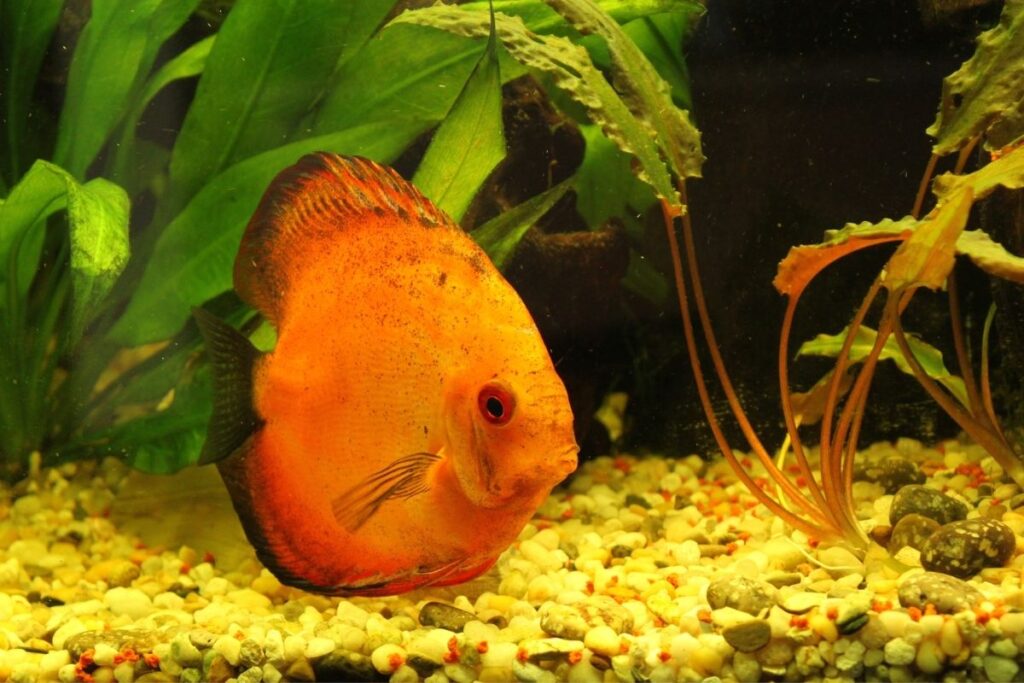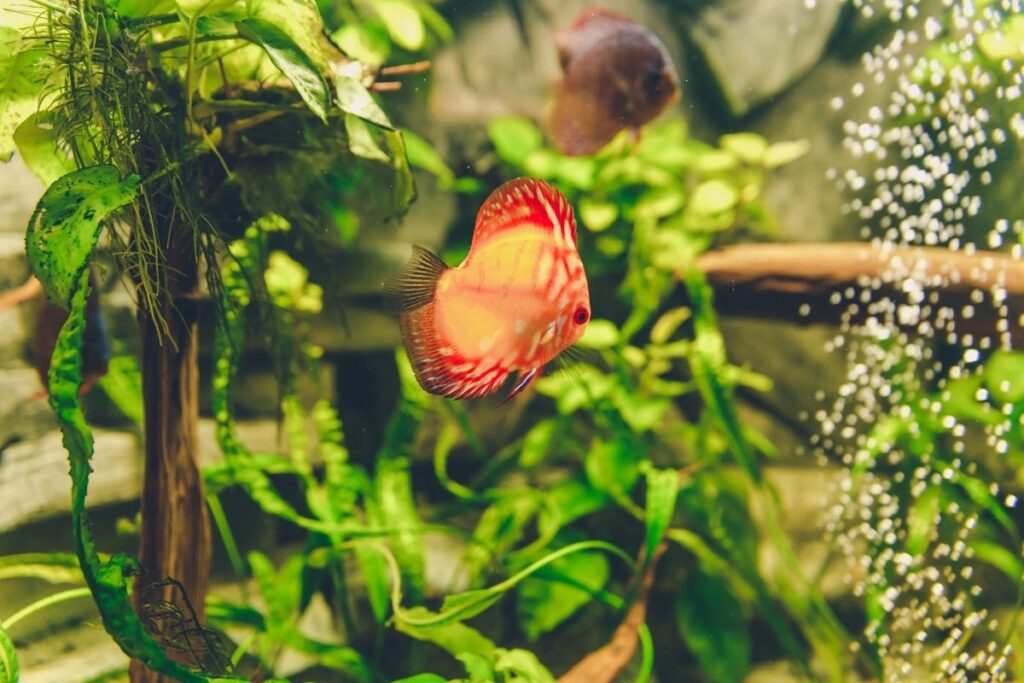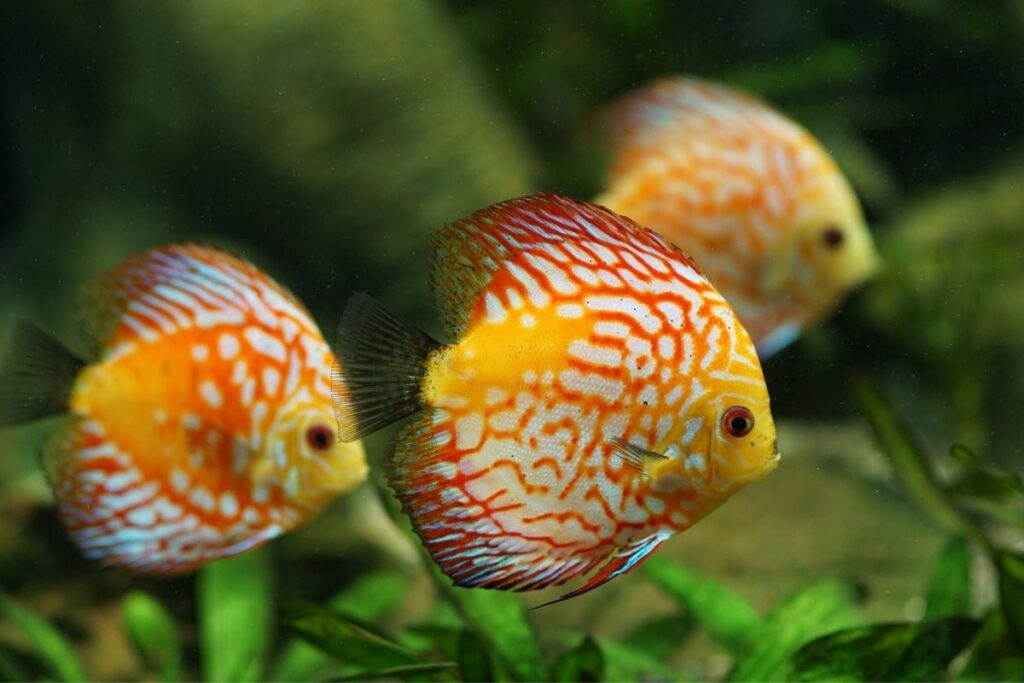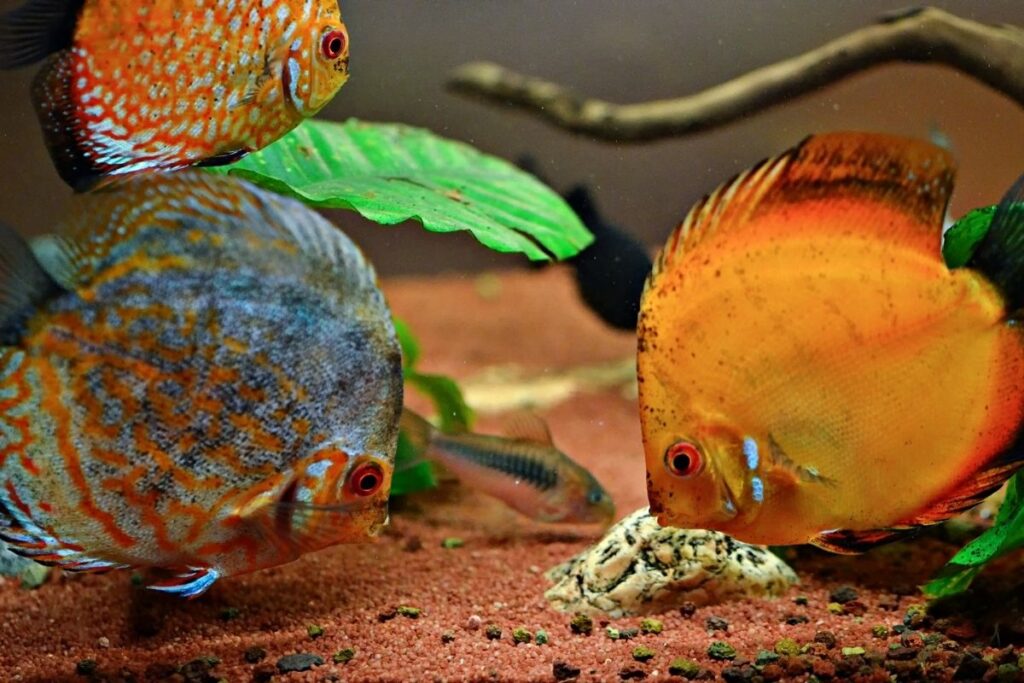If you’re considering getting a discus fish, you’re in for a treat. These beautiful fish are known for their vibrant colors and graceful swimming. However, discus fish care can be a bit more challenging than caring for other types of fish. As an experienced discus fish owner, I’ve learned a lot about how to keep these fish happy and healthy. In this article, I’ll share everything you need to know about discus fish care.
Discus fish require a well-maintained aquarium with suitable water conditions, a varied diet, and a peaceful environment. They need a pH range of 6.0-7.5 and a temperature range between 82-86°F. The aquarium should be planted, and regular water changes should be performed to ensure their health. They are peaceful and social fish, making them an excellent choice for community tanks.
First, it’s important to understand that discus fish are sensitive creatures. They require a specific environment to thrive, including warm water temperatures, a low-stress environment, and a balanced diet. Additionally, discus fish are social creatures and do best when kept in groups of at least six. I’ll cover all of these topics and more in this comprehensive guide to discus fish care.
Whether you’re a first-time fish owner or an experienced aquarist, this article will provide you with all the information you need to care for your discus fish. From setting up the perfect tank to feeding and breeding your fish, I’ll cover it all. So, let’s dive in and learn everything there is to know about discus fish care.

Table of Contents
Species Summary
Origin
Discus fish are native to the Amazon River basin in South America.
They can be found in slow-moving waters with a lot of vegetation, such as floodplains, tributaries, and lakes.
Lifespan
Discus fish can live up to 10 years in captivity if they are taken care of properly.
The lifespan of a discus fish can be affected by a number of factors, including water quality, diet, and stress levels.
Appearance
Discus fish are known for their vibrant colors and distinctive patterns. They can range in color from bright red to blue, green, and yellow.
They have a round, flat body shape and can grow up to 8 inches in length.
Size
Discus fish can grow up to 8 inches in length, but the average size is around 6 inches.
It’s important to provide them with enough space to swim around and explore their environment.
Growth Rate
The growth rate of discus fish can vary depending on a number of factors, including water quality, diet, and genetics.
It’s important to monitor their growth and adjust their care accordingly.
Behavior & Temperament
Discus fish are generally peaceful and social creatures.
They enjoy swimming in groups and can become stressed if they are kept alone.
They can be shy at first, but they will become more comfortable with their environment over time.
Male vs Female
It can be difficult to determine the sex of discus fish, as they do not have any obvious physical differences.
However, males are typically larger and more colorful than females.
When I first started keeping discus fish, I was amazed by their vibrant colors and unique personalities.
They quickly became one of my favorite fish to care for, and I’ve learned a lot about their needs and behaviors over the years.
By providing them with a spacious and well-maintained environment, a balanced diet, and plenty of social interaction, you can help your discus fish thrive and live a long, healthy life.
Types of Discus Fish
Discus fish are known for their vibrant colors and unique patterns.
There are several types of discus fish, each with its own distinct characteristics. In this section, I will discuss some of the most popular types of discus fish.
First, there is the Blue Discus. As the name suggests, this fish has a beautiful blue color that is sure to catch your eye. They are also known for their round shape and large eyes.
Next, we have the Red Discus. This fish has a deep red color that is truly stunning. They are also known for their unique pattern, which almost looks like a maze.
Another popular type of discus fish is the Green Discus. This fish has a bright green color that is sure to add a pop of color to any aquarium. They are also known for their peaceful temperament.
The Brown Discus is another popular type of discus fish. They have a brownish-red color and are known for their unique pattern. They are also known for being easy to care for, making them a great choice for beginners.
Finally, there is the Heckel Discus. This fish has a beautiful pattern of stripes and spots that is sure to catch your eye. They are also known for their peaceful temperament and are a great addition to any community tank.
Overall, there are several types of discus fish to choose from, each with its own unique characteristics. Whether you are a beginner or an experienced fish keeper, there is sure to be a discus fish that is right for you.
Setting up a Discus Fish Tank
Tank Size
I recommend a minimum tank size of 55 gallons for a single discus fish, but if you plan on keeping a group, you’ll need a larger tank.
I personally keep my discus in a 75-gallon tank, and they seem to be thriving.
Lighting
Discus fish prefer low to moderate lighting, so it’s best to avoid bright lights.
I use a simple LED light that provides just enough light for my plants to grow, but not too much to stress out my fish.
Filtration System
A good filtration system is crucial for keeping your discus fish healthy.
I recommend using a canister filter or a sump filter, as they provide excellent mechanical and biological filtration. Be sure to choose a filter that is rated for the size of your tank.
Aeration
Discus fish require plenty of oxygen, so it’s important to have good aeration in your tank.
I use an air stone and a powerhead to create a gentle current in my tank, which helps to oxygenate the water.
Heater
Discus fish are tropical fish and require a consistent water temperature of around 82-86°F.
I recommend using a high-quality heater and a thermometer to ensure that the temperature remains stable.
Substrate
I prefer to use sand as a substrate in my discus tank, as it is easy to clean and doesn’t trap debris like gravel can.
Be sure to choose a substrate that is gentle on your fish’s delicate fins.
Decoration
Discus fish appreciate a well-decorated tank, so feel free to add some rocks, driftwood, and other decorations.
Just be sure to avoid sharp edges that could harm your fish.
Plants
Live plants not only look beautiful in a discus tank, but they also provide important benefits such as oxygenation and natural filtration.
I recommend using hardy plants like Java fern and Anubias, as they are easy to care for and can thrive in a discus tank.

Overall, setting up a discus fish tank requires careful consideration and planning.
By following these guidelines, you can create a beautiful and healthy environment for your discus fish to thrive in.
Maintaining Water Quality
Water Temperature
I always make sure to keep the water temperature in my discus fish tank between 82°F to 86°F.
This is the ideal temperature range for discus fish, as it mimics their natural habitat in the Amazon River. Too low or too high temperatures can cause stress and even death to your fish.
Water pH
The pH level of the water in your discus fish tank should be between 6.0 to 7.5.
Discus fish are sensitive to pH changes, so it’s important to maintain a stable pH level. You can use a pH testing kit to monitor the pH level and adjust it accordingly.
Water Hardness
Discus fish prefer soft water with a hardness level between 1 to 8 dGH.
Hard water can cause stress and health problems for your fish.
You can use a water hardness testing kit to check the hardness level and add soft water if needed.
Water Changes
I change 25% of the water in my discus fish tank every week.
Regular water changes help maintain water quality by removing harmful chemicals and waste products.
Make sure to use a water conditioner to remove chlorine and chloramine from tap water before adding it to the tank.
Monitoring Water Quality
I always monitor the water quality in my discus fish tank using a test kit.
This helps me keep track of the ammonia, nitrite, and nitrate levels in the water.
High levels of these chemicals can be harmful to your fish, so it’s important to keep them at safe levels by doing regular water changes and maintaining a healthy biological filter.
Feeding Your Discus Fish
Types of Food
When it comes to feeding your discus fish, it’s important to provide them with a variety of foods to ensure they receive all the necessary nutrients.
In my experience, a combination of high-quality pellets, frozen foods, and live foods works best.
For pellets, I recommend choosing a brand specifically formulated for discus fish. Look for pellets that contain high levels of protein and little to no fillers or additives.
For frozen foods, bloodworms, brine shrimp, and daphnia are all great options. And for live foods, you can’t go wrong with blackworms or grindal worms.
Feeding Schedule
Discus fish should be fed two to three times a day, with small portions at each feeding.
Overfeeding can lead to health problems, so it’s important to stick to a consistent feeding schedule and avoid overfeeding.
I personally feed my discus fish in the morning, afternoon, and evening. I find that this schedule works well for them and helps keep them healthy and happy.
Feeding Techniques
When feeding your discus fish, it’s important to ensure that the food is sinking to the bottom of the tank.
Discus fish are bottom feeders, so they prefer to eat food that has sunk to the bottom rather than food that is floating on the surface.
To ensure that the food is sinking, you can use a feeding cone or simply drop the food near the bottom of the tank.
It’s also important to remove any uneaten food after each feeding to prevent it from polluting the water.
Overall, feeding your discus fish a variety of high-quality foods on a consistent schedule is key to keeping them healthy and happy.
By following these tips, you’ll be well on your way to providing your discus fish with the best possible care.
Personally, I’ve found that my discus fish are particularly fond of frozen bloodworms. Whenever I feed them bloodworms, they get so excited and swim around like crazy! It’s always fun to watch them enjoy their food.
Tank Mates for Discus Fish
When it comes to choosing tank mates for your discus fish, it’s important to consider their unique temperament and behavior.
Discus fish are peaceful and social creatures, but they can be easily stressed by aggressive or territorial tank mates.
Personally, I’ve found that keeping discus fish with other peaceful species has worked well for me. Some great options include cardinal tetras, neon tetras, and rummy nose tetras.
These small, colorful fish not only add visual interest to your tank, but they also create a natural environment that mimics the discus fish’s native habitat.
Another great option for tank mates are bottom-dwelling fish, such as corydoras catfish.
These fish help keep the tank clean by eating leftover food and debris, and they also add variety to your tank’s ecosystem.
One thing to keep in mind is that discus fish can be sensitive to water conditions, so it’s important to choose tank mates that have similar water requirements.
Avoid adding aggressive or territorial fish, as they can cause stress and potentially harm your discus fish.
Keeping Discus Fish Together: How Many is Too Many?

When it comes to keeping discus fish, one of the most important considerations is how many fish to keep together in a tank.
As a discus fish owner myself, I’ve learned through trial and error that there are a few key factors to keep in mind when deciding how many fish to add to your tank.
First and foremost, it’s important to remember that discus fish are social animals and thrive in groups.
However, overcrowding your tank can lead to stress, aggression, and even disease. As a general rule of thumb, you should aim to keep no more than one discus fish per 10 gallons of water.
It’s also important to consider the size of your tank when deciding how many discus fish to keep.
While it may be tempting to add more fish to a larger tank, keep in mind that discus fish prefer a well-established hierarchy and may become aggressive if their territory is threatened.
For a 55-gallon tank, I recommend keeping no more than six discus fish.
Another factor to consider is the gender of your discus fish. Male discus fish are generally more aggressive and territorial than females, so it’s important to keep a balance of both genders in your tank.
A good ratio to aim for is one male discus fish for every two or three females.
Ultimately, the key to keeping discus fish healthy and happy is to provide them with a well-maintained tank that meets their specific needs.
By keeping the number of fish in your tank in check and paying attention to their behavior, you can create a thriving community of discus fish that will bring you joy for years to come.
Personally, I started with a group of four discus fish in my 40-gallon tank, and I found that they did well together for several months.
However, as they grew larger, I noticed that they were becoming more aggressive with each other, so I decided to add a fifth fish to help balance out the hierarchy.
Since then, my discus fish have been thriving and getting along well, and I’ve even noticed some breeding behavior!
Common Health Issues
Common Diseases
Discus fish are susceptible to several diseases, including fin rot, ich, and velvet disease.
These diseases are caused by bacteria, parasites, or fungi and can be introduced to the tank through new fish or contaminated water.
Keeping the tank clean and properly maintained can help prevent the spread of disease.
Symptoms of Illness
It’s important to monitor your discus fish for signs of illness.
Symptoms of illness can include loss of appetite, lethargy, abnormal swimming behavior, and visible physical abnormalities like discoloration or lesions.
Recognizing these symptoms early can help prevent the spread of disease and increase the chances of successful treatment.
Prevention and Treatment
Preventing disease in discus fish involves maintaining a clean and stable environment.
This includes regular water changes, proper filtration, and avoiding overfeeding. If your fish do become sick, there are several treatment options available.
These include medicated food, water treatments, and quarantine tanks.
Personally, I’ve found that prevention is key when it comes to keeping discus fish healthy. I make sure to keep the tank clean and well-maintained, and I always quarantine new fish before introducing them to the main tank. By staying vigilant and taking proactive measures, I’ve been able to keep my discus fish healthy and happy for years.
Signs of Sick Discus Fish
As a discus fish owner, it is important to be able to recognize the signs of a sick fish. Here are some common symptoms to look out for:
- Loss of appetite
- Abnormal swimming behavior (such as swimming upside down)
- Clamped fins
- White spots on the body (indicating ich)
- Red streaks on the fins or body (indicating bacterial infection)
- Gasping at the surface of the water (indicating low oxygen levels)
If you notice any of these symptoms in your discus fish, it is important to take action quickly. The longer you wait, the worse the condition can become.
Personally, I once had a discus fish that stopped eating and became very lethargic. I quickly realized that it was suffering from a bacterial infection and treated it with antibiotics. Fortunately, it made a full recovery.
Remember, prevention is key when it comes to keeping your discus fish healthy. Make sure to maintain a clean and well-filtered tank, provide a balanced diet, and monitor your fish regularly for any signs of illness.
Signs of Healthy Discus Fish
As an avid discus fish owner, I know how important it is to keep them healthy and happy. Here are some signs to look out for to ensure your fish are in good health:
Firstly, healthy discus fish should have bright and vibrant colors. The colors should be consistent and not faded or dull. If you notice that your discus fish are losing their color, it could be a sign of stress or illness.
Secondly, healthy discus fish should have a round and full body shape. They should not appear skinny or emaciated. If you notice that your fish are losing weight, it could be a sign of malnutrition or illness.
Thirdly, healthy discus fish should have clear and bright eyes. Their eyes should not be cloudy or sunken. If you notice any abnormalities in their eyes, it could be a sign of an underlying health issue.
Lastly, healthy discus fish should be active and alert. They should swim around the tank and interact with their environment. If you notice that your fish are lethargic or not moving much, it could be a sign of illness or stress.
By keeping an eye out for these signs, you can ensure that your discus fish are healthy and happy in their environment. Remember to maintain a clean and well-balanced tank, provide them with a nutritious diet, and give them plenty of love and attention.
Breeding Discus Fish
Signs of Discus Fish Breeding
As a discus fish owner, it’s important to be able to identify when your fish are ready to breed.
One of the most obvious signs is when the fish start to clean a flat surface, such as a leaf or the side of the tank.
This is where they will eventually lay their eggs. You may also notice the fish becoming more territorial and aggressive towards other fish in the tank.
Mating Behavior

Once the discus fish have identified a suitable breeding surface, they will begin their mating ritual. The male will start to court the female by swimming around her and displaying his fins.
If the female is receptive, she will follow the male to the breeding site and the two will align themselves vertically. The female will then lay her eggs, which the male will fertilize.
Preparing for Breeding
If you want to encourage your discus fish to breed, it’s important to create the right environment for them.
This means providing a clean and spacious tank, with plenty of hiding places and flat surfaces for the fish to lay their eggs.
You should also make sure the water is at the right temperature and pH level, as this can have a big impact on the breeding process.
Personally, I found that my discus fish were much more likely to breed when I added a breeding cone to their tank.
This is a cone-shaped object that the fish can lay their eggs on, and it seems to be very effective at stimulating breeding behavior.
Raising Fry
Once the eggs have been fertilized, they will hatch after around 48 hours. At this point, it’s important to remove the fry from the breeding site and transfer them to a separate tank.
The fry will need to be fed a special diet of brine shrimp and other small foods, and the water will need to be kept very clean to prevent disease.
Overall, breeding discus fish can be a rewarding and fascinating experience.
By understanding the signs of breeding, creating the right environment, and taking good care of the fry, you can successfully raise a new generation of these beautiful fish.
Recommended Products:
- Fluval FX4 Canister Filter – This filter provides excellent mechanical and biological filtration and is suitable for tanks up to 250 gallons.
- Hygger Aquarium Air Stone Kit – This kit includes an air stone and a powerhead to create a gentle current in your tank, which helps to oxygenate the water.
- Aqueon Pro Adjustable Heater – This high-quality heater is adjustable and can maintain a consistent temperature in your tank.
- CaribSea Super Naturals Sand – This sand is gentle on your fish’s delicate fins and is easy to clean.
- Current USA Satellite Freshwater LED Plus Light – This LED light provides low to moderate lighting, which is ideal for discus fish. It also has customizable color options to enhance the beauty of your tank.
- API Freshwater Master Test Kit – This test kit allows you to monitor the water quality in your tank, including pH, ammonia, nitrite, and nitrate levels. This is important for maintaining a healthy environment for your discus fish.
Conclusion
Discus fish are one of the most beautiful and fascinating freshwater fish you can keep in your aquarium. They require a bit of extra care to thrive, but with the right setup and attention, they can live long and healthy lives.
Throughout this article, I’ve shared everything I’ve learned about discus fish care, from setting up the perfect tank to feeding, water changes, and more. I hope you’ve found this information useful and that it helps you create the ideal environment for your discus fish.
One thing I’ve learned from my own experience with discus fish is that they have unique personalities and behaviors. For example, I have one discus fish that loves to hide behind a plant and watch me as I work on my computer. It’s almost like he’s keeping an eye on me!
If you’re considering adding discus fish to your aquarium, I encourage you to do so. They are truly one of the most rewarding fish to keep, and with the right care, they can bring you years of joy and entertainment.
FAQs
As a discus fish owner, you may have a lot of questions about the care and maintenance of your fish. Here are some of the most frequently asked questions:
Q: How often should I feed my discus fish?
A: It is recommended to feed your discus fish two to three times a day, with small amounts of food each time. Overfeeding can lead to health problems, so be sure to monitor the amount of food your fish are consuming.
Q: What should I feed my discus fish?
A: Discus fish require a varied diet, including high-quality flakes, pellets, and frozen or live foods such as brine shrimp and bloodworms. It is important to provide a balanced diet to ensure the health and vitality of your fish.
Q: How often should I perform water changes?
A: It is recommended to perform a 25% water change once a week to maintain water quality and prevent the buildup of harmful toxins. However, if you have a heavily stocked tank, you may need to perform water changes more frequently.
Q: What is the ideal water temperature for discus fish?
A: Discus fish require a water temperature between 82-86°F (28-30°C) to thrive. It is important to maintain a consistent water temperature to prevent stress and illness in your fish.
Q: Can I keep discus fish with other fish?
A: Discus fish can be kept with other peaceful fish that require similar water conditions. Avoid keeping them with aggressive or fin-nipping fish, as this can lead to stress and injury.
Personal Anecdote:
When I first started keeping discus fish, I was nervous about their care and maintenance. However, with research and dedication, I have been able to provide a healthy and thriving environment for my fish. Don’t be afraid to ask questions and seek advice from other experienced discus fish owners!
Reference: Wikipedia.
